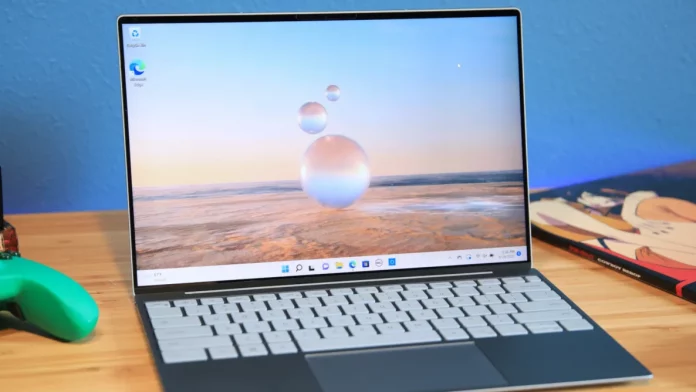Dell. An actor who received his letters of nobility from the common population after previously receiving them from professionals. Its XPS line immediately rose to prominence due to its high quality, and the company has worked to develop it ever since. The Dell XPS 13 9315 that we are testing today is unique. There is just one. It uses Intel’s 12th generation. What about the rest? That’s a good question.

TECHNICAL SHEET :
| Model | Dell XPS 13 (9315) |
|---|---|
| Screen size | 13.4 inches |
| Definition | 1920 x 1080 pixels |
| Display technology | LCD |
| Touchscreen | Non |
| Processor (CPU) | Core i5-1230U |
| Graphics chip (GPU) | intel Iris Xe |
| Memory (RAM) | 8 Go |
| Internal memory | 256 Go |
| Wi-Fi standards | Wi-Fi 6 (ax) |
| Version du Bluetooth | 5.2 |
| Operating system (OS) | Microsoft Windows 11 |
| Dimensions | 199,40 x 13,99 x 295,40 mm |
| Weight | 1170 grammes |
| Repairability Index? | 6,9/10 |
| Prix | 1 299 € |
DESIGN :
Is there a word, phrase, or metaphor that hasn’t been used to describe the design of a Dell XPS 13? The firm isn’t known for exceeding user expectations, as seen by the Dell XPS 13 Plus that we just evaluated. Which isn’t a terrible thing, since he could look us in the eyes and say, “but we already had everything perfect from the start, why change?” We’d need a few minutes to come up with incredibly strong arguments to counter him.

Frame made of metal. Check. Finishes were achieved to the millimeter. Check. A solemn elegance, full of restraint, that does not aim to impress because it knows, deep down, that it is impressive? Check. The single criticism I’ve ever had about the design of a Dell XPS 13 has always been the same, and I’m the only person I know who has this impression: the hull coating looks strange to me. on the backs of my hands Not all the time, perhaps once a day. As if the ultrabook was charged with a very small static electricity that causes my skin to faintly vibrate. A brief yet unpleasant impression.

But let me emphasize once more: I am the only person I know who has this “issue.” And, if I emphasize it for the first time today, it is confirmation of what these initial paragraphs truly are: an attempt to locate the little beast on a laptop whose manufacture is now so precise that it is nearly faultless. At least for what it aspires to be: a Dell XPS 13.
READ ALSO : The New Watch from Gramin
Keyboard & Touchpad :
The Dell XPS 13s’ space efficiency is still excellent. The keyboard is spacious, with well-spaced keys, but the manufacturer makes no concessions for this. At the very least… If we ignore the arrows, the top and bottom must share a single space. It’s difficult for me to assess because I’ve never used them. The switches themselves are quite firm, yet have little travel, making the keystroke seem sudden. Dell, on the other hand, manages to make it quiet and comfy. However, if you type as often as I do, the keyboard may be less comfortable for you than for the rest of us.

The touchpad is once again a little letdown. Not because of its inherent quality, which is superb, but because of its size, which is still fairly little in comparison to contemporary trends. However, Dell just prefers its keyboard, which is undoubtedly a wonderful quality for somebody who prioritizes office automation over all else. Isn’t that consistent with the brand?
Connectors :
What’s less appealing is the device’s insistence on forcing us to live the “dongle life,” as it’s known, with only two ports: a USB-C on the left and one on the right.
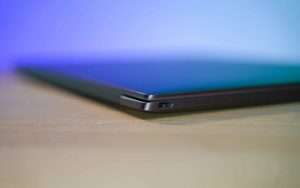
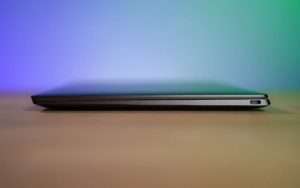
Although there are two Thunderbolt 4 ports that will allow you to connect the most powerful (and sometimes a bit insane) devices on the market, a USB A port or an SD card reader might make or break this arrangement. The compromise appears to be essential in order to achieve this small and rounded shape on the Dell XPS 13, but it does not prevent it.
Webcam & Audio :
Are the colors really so bad? Obviously, a 720p sensor will neither improve the definition or the stake. At the very least, Dell incorporates a Windows Hello sensor for facial identification, as well as a power button with a fingerprint reader. The allure? No, but yes to security.
Dell has managed to position itself among the top on the Windows market for audio, and this Dell XPS 13 maintains its pace. Although the bass is not as strong as it is on the 15-inch variant, which competes well with MacBooks in this category, we must acknowledge that the Dell XPS 13’s sound characteristic is superior to the majority. Furthermore, the small one develops an incredible maximum volume of power and quality! I’ve had Bluetooth speakers with poor sound quality.
SCREEN :
The Dell XPS 13 in our test configuration, the most affordable offered by the company, is equipped with an IPS LCD screen with a maximum resolution of 1920 x 1200 pixels, i.e. a 16:10 aspect ratio. This screen has a maximum refresh rate of 60 Hz, making it fairly basic and haptic. It should be noted that the optimal choice enables 4K resolution with 90% DCI P3 coverage.

We can observe from our probe and the DisplayCal software that the manufacturer has not attempted to conceal any flaws with its screen. We found 104.9% sRGB coverage, compared to 72.3% for Adobe sRGB and 74.3 for DCI-P3. The maximum brightness is 490 cd/m2, with a contrast ratio of 1828:1. However, the colorimetry is not ideal, with an average color temperature of 6142K and a Delta E00 of 2.06. Simply excellent.

This is precisely where we experience disappointment. Even though it is the most cheap model, other rivals, like as Asus, have already begun to popularize a refresh rate of 90 Hz, OLED screens, or even DCI-P3 optimization in these price categories. Dell maintains its momentum in the face of competition.
READ ALSO : Dreame L10s Ultra review
SOFTWARE :
Really, McAfee? The rest of the software includes the standard MyDell suite as well as the Dell Command Update. The latter helps you to discover driver and firmware updates for your XPS 13, whilst the former lets you to enable features like as extreme performance mode and presence detection. When you are not actively using the computer, you may set it to sleep automatically.
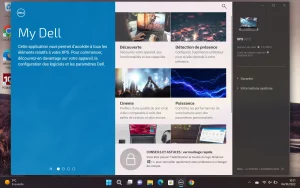

This choice will have had the effect of having me scratch the top of my head, bemused, trying to figure out why the PC went off automatically the moment I slumped into my sofa at the start of a session. The feature will undoubtedly be appealing in a professional setting where information breaches are unacceptable.
PERFORMANCES :
The Intel Core i5-1230U processor in our evaluation model is at the core of our Dell XPS 13 review. Intel’s newest 10-core, 12-thread SoC with a turbo clock speed of 4.4GHz. It is supported here by 16 GB of 5200 MHz LPDDR5 RAM and 512 GB of PCIe Gen 4 storage capacity.
General Benchmarks :
We may be saddened by the lack of a Core i7 processor on this model this year, but our benchmarks show that Dell simply made the correct decision. With a single core score of 1443 and a multi core score of 5324 in Cinebench R23, and an overall score of 4772 on PCMark 10, the i5-1230U performs comparable to the Core i7-1250U found in this year’s Zenbook 17 Fold.
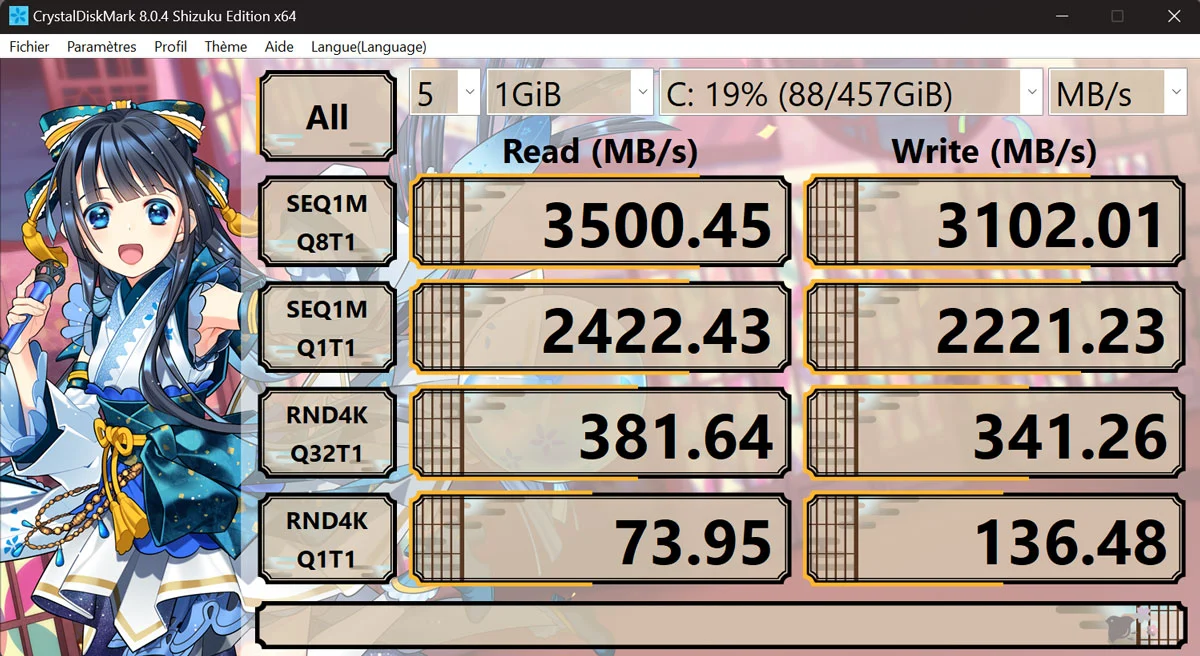
The more we test them, the clearer it becomes that the difference between the i7s and i5s on Intel’s 12th generation processors is small. Don’t get your hopes up on this one this year. You’ll have plenty to do any workplace or light creative activity quickly and easily. In terms of storage, we’re stuck with the limitations of a PCIe Gen 4 SSD.
Cooling and Noise :
The most significant benefit that we can derive as a manufacturer from not dramatically altering its architecture is the ability to optimize its cooling as much as feasible. When pushed to its limits in synthetic testing, the Dell XPS 13 only warms up to 38°C on the keyboard and 44.5°C at the device’s bottom. This heat is far from bothersome and, moreover, fades extremely effectively.

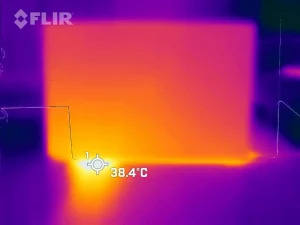
AUTONOMY :
The Dell XPS 13 comes with a modest 3-cell battery with a capacity of 51 Wh and a 45 W USB-C charger. The latter, of course, uses the Power Delivery standard, so you can use it with any charger that supports this standard to quickly and efficiently charge the Dell XPS 13.
We can depend on the Dell XPS 13 for roughly 9 hours of use while connected to a good 5 GHz Wi-Fi, with a tiny music tab on the side and a few unwarranted YouTube breaks while writing multiple articles. A good score, which has devolved into a basic ” decent ” score when Apple launched its ARM SoCs. The thing is, you can rely on this Ultrabook for a nice day at work, but you’ll need to charge it in before you watch Netflix and relax at home.
PRICE AND AVAILABILITY :
The suggested price for the Dell XPS 13 9315 in our test configuration is 1249 euros. It is also available with a Core i7-1250U processor for 1359 euros.


